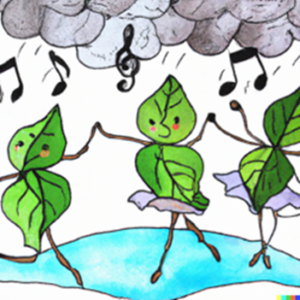Chapter 2: Keep Calm and Doodle On
2.4. Plan for your learners to doodle
Integrating doodles into classroom activities can make learning more engaging and foster creativity, empathy, and mindfulness. The goal is not to rigidly follow a lesson plan but to give space for learners’ ideas to flourish by encouraging them to create their own doodles. Use the following steps, sample plan and template outline as a flexible framework, allowing the class to evolve organically.
2.4.1. 6-Step Approach
Select a topic or concept from your subject specialisation and the duration of your class. Pick a concept that could benefit from visual representation.
Step 1: Identify the goals and objectives for integrating doodles into your subject. Think about how doodles can make concepts clearer and more relatable, while also allowing learners to express their understanding creatively.
Stick to a couple of ‘do-able’ and relevant objectives. Specify only integration objectives related to doodles. Note the materials that you would require for this class.
Step 2: Plan your introduction and/or initial instructions before introducing the doodling activity. This can include introduction of new concepts or revision of previously taught concepts.
Step 3: Design your prompts for getting learners to doodle: Make these as clear as possible. Learners may not be used to doodling, hence it may also be essential to showcase different kinds of lines/shapes that can be drawn. You may also model out a doodle.
Remind learners that doodles are not diagrams; they are personal, creative interpretations. Guide them with prompts but give them the freedom to explore their ideas.
Step 4: Describe integration of SEL: Indicate how learners would interact with the doodle to develop, hone and/or showcase empathy, mindfulness, critical thinking and compassion.
Step 5: Evaluate and implement your plan.
- Is the doodling activity aligned with the course content?
- Can the doodling activity be completed by the learners in the given time period?
- Does the doodling activity help the learners to achieve at least one of the following: empathize with concepts/characters, be mindful, display critical thinking and/or compassion?
Further, you may use this single-point rubric added in Annexure I to note your strengths or areas to improve through self or peer feedback.
Implement your plan and monitor learner participation:
- Are only a few learners involved, or is there broad participation?
- Are learners engaged or confused?
Be mindful of potential emotional triggers (e.g., topics related to water scarcity or pollution).
Record your observations and adapt accordingly for the next session.
Step 6: Share and Discuss: Feel free to share your plan with colleagues to inspire more creative approaches. You may also share your plans to the online community of educators.
2.4.2. Sample Plan
Kindly note that this is a rough outline and not a detailed lesson plan. At this ideation stage, it is okay to restrict the lesson plan to an outline, which lends much-needed flexibility and allows the class to evolve.
Title: Germination
Learning Objective: Learners will be able to: [Only Doodle integration outcomes are specified here]
- Identify key stages in the germination process.
- Create a doodle that visually explains the germination process.
Materials: Learners can use any materials they have: pens, pencils, or digital tools.
Teaching-Learning Practice:
Steps for integration
- The educator introduces the process of germination to learners: Briefly explain the germination process to learners. Discuss how seeds transform into saplings and the factors that influence this growth.
- Prompts for getting learners to doodle: In groups or individually, the educator asks learners to doodle using the following prompts :
-
- Prompt 1: What are the factors that affect germination? (e.g. water, sunlight, soil) Doodle the elements as characters interacting with the seed.
- Prompt 2: How does the seed feel during each stage of growth? Doodle the seed in different mental and emotional states (sleepy, determined, triumphant etc.) as it grows.
- Prompt 3: What qualities do the seed embody? Can we say that the seed is persevering? Can you compare the sapling to something else? For example, visualize the seed as a warrior breaking out of its shell or as a dancer reaching for the sun.

- Prompt 4: How do other elements like the sun, soil, and water support the sapling? Doodle this interdependence, showing cooperation and mutual support. For example: The tender leaves and offshoots sway gracefully like early ballet dancers, while the rain clouds above play their rhythmic symphony, like musicians accompanying a delicate performance.

Create a story through doodles by illustrating interactions between characters. For example, imagine the sprouted seed politely asking a nearby pebble for support, as if seeking a helping hand on its journey to grow. 
- Using SEL elements :
-
- Empathy: Doodling the seed as a character allows learners to humanize natural processes. Imagining the seed’s struggle to sprout encourages learners to empathize with the effort and resilience involved in growth. This perspective can deepen their understanding of perseverance in both plants and people, and helps build a connection with the natural process of germination.
- Mindfulness: By observing the stages of germination closely and expressing them visually, learners practice being present and attentive. The doodling process encourages them to slow down and reflect on the gradual, purposeful transformation of a seed into a plant.
- Critical Inquiry: Transforming the seed into a dynamic character helps learners question and rethink conventional representations. For example, they may explore why some seeds sprout more easily than others or how environmental challenges affect growth. This approach nurtures curiosity and analytical thinking.
- Compassion: Personifying the seed as a vulnerable and determined being fosters compassion, as learners imagine what the seed might “feel” while pushing through the soil or struggling to find light. This can parallel human experiences of challenge and growth, helping learners identify resilience in both natural and social contexts.
It’s now your turn to create your own integration plan. You can use the template below to structure your ideas.
2.4.3. Template: Plan for your learners to doodle
| Topic: | Duration: |
Step 1: State the learning objectives. [Restrict to a couple of ‘do-able’ and relevant objectives. Specify only integration objectives related to doodles]
| Learners will be able to … |
Step 2: Introduction of concept
Step 3: Prompts for getting learners to doodle:
Step 4: State the use of (at least one): Empathy, Mindfulness, Critical Inquiry, Compassion
Step 5: Pause and evaluate your plan before you share.
- Is the doodling activity aligned with the course content?
- Can the doodling activity be completed by the learners in the given time period?
- Does the doodling activity help the learners to do at least one of the following: empathize with concepts/characters, be mindful, display critical thinking and/or compassion?
You may use a single-point rubric in Annexure I.
Step 6: Showcase your creation: You can upload it here.
Media Attributions
- Doodles 1 for Sample lesson plan © Natasha Gomes is licensed under a CC BY (Attribution) license
- Doodle 2 for Sample lesson plan © Natasha Gomes is licensed under a CC BY (Attribution) license
- Doodles 3 for Sample lesson plan © conceptualised by Ajita Deshmukh and illustrated by Natasha Gomes is licensed under a CC BY (Attribution) license



